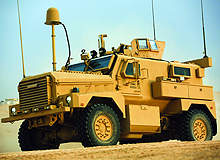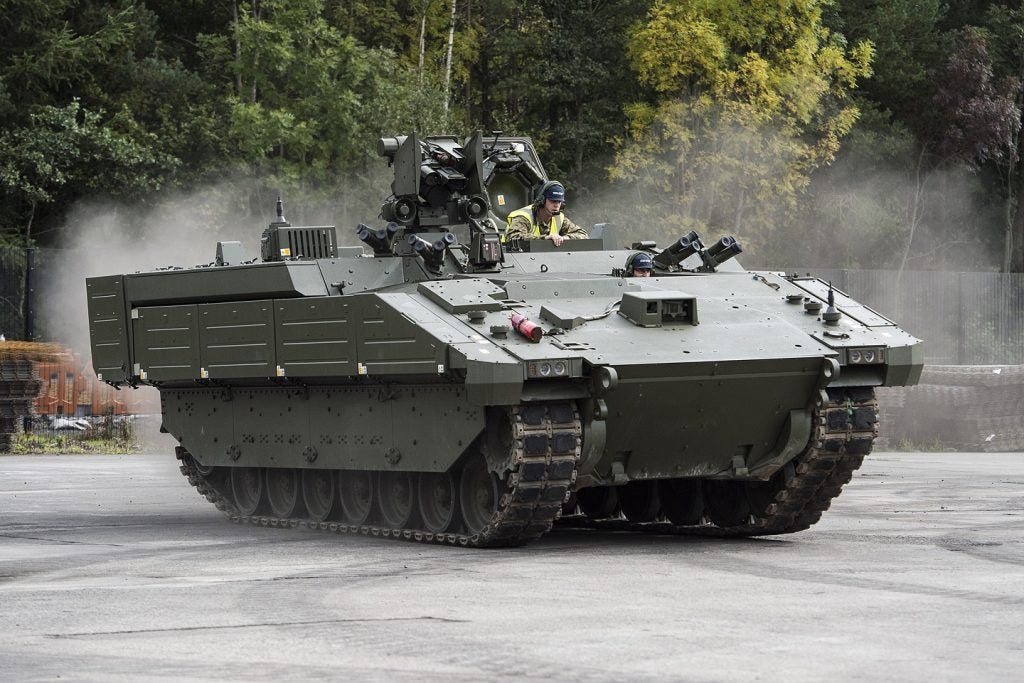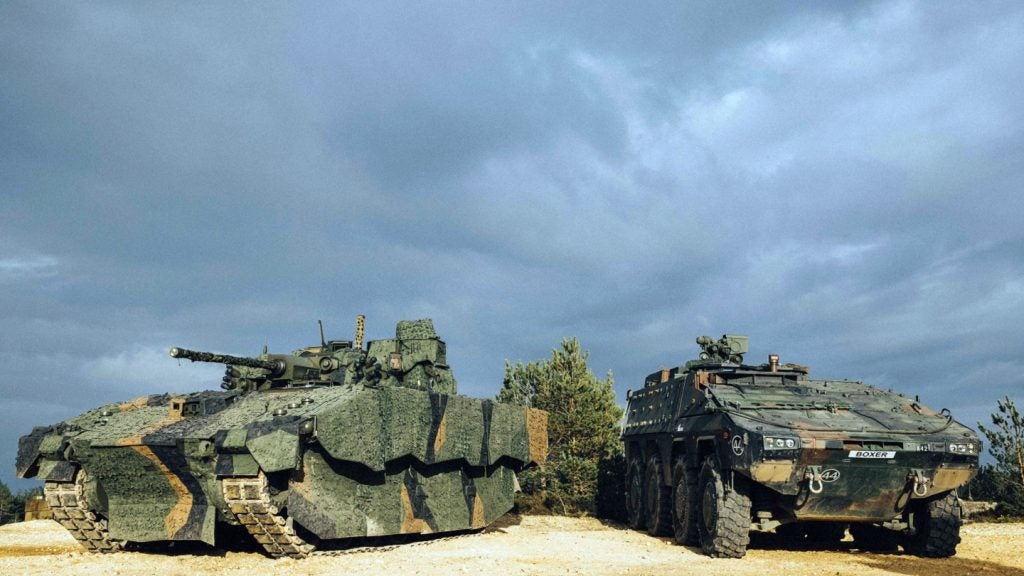
The invasions of Iraq and Afghanistan began as a demonstration of what could be achieved by the deployment of overwhelming force, supported by the best equipment technology could provide. The aftermath of both operations has, though, proved very different from the promise of these early plans. In the ensuing years, Nato forces were forced to react swiftly to challenges posed by the evolving tactics adopted by insurgents in both theatres.
The increasing deployment of the IED as a weapon of choice wrong-footed conventional military planning and it rapidly became apparent that conducting counter-insurgency operations using conventional weapons and equipment would not succeed. The challenge was to develop new equipment fast enough to meet the needs of the troops on the ground, needs that changed as the threat continued to evolve in response to tactical and technical countermeasures. This provoked the design evolution of light and medium protected vehicles during the conflicts.
The source of the problem
The failure to secure Iraqi arms depots in the aftermath of the invasion and the wholesale disbandment of the Iraqi Army ensured that the insurgency had an excellent supply of ordnance, principally 152mm shells, and plenty of trained personnel. Early attempts at providing protected mobility to counter the threat posed by such devices and by ambushes focused principally on modifying the available resources in the shape of conventional vehicles, such as MBTs, IFVs and APCs, and the logistic vehicle fleet.
While they undoubtedly had a part to play, however, heavier vehicles lacked the mobility and flexibility necessary for day to day operations. In order to adapt vehicles to meet the demands of the major counter-insurgency that followed, recourse was quickly made to a variety of appliqué solutions – bar armour to counter attack by RPGs, ECM to counter remotely initiated IEDs, and various forms of protection for top cover sentries. To take the example of the HMMWV, the effect was to change the basic M998 vehicle from the 1980s, with a GVW of 3.5t-4t into a quite different vehicle altogether.
Laden with appliqué armour packs, top cover sentry protection and a plethora of special to role equipment, the M1114 HMMWV introduced in the early 2000s has a GVW of between 5.5t-6.5t, an extraordinary increase for a relatively light vehicle, and one that has an enormous impact on the mobility, reliability and durability of the base chassis.
How well do you really know your competitors?
Access the most comprehensive Company Profiles on the market, powered by GlobalData. Save hours of research. Gain competitive edge.

Thank you!
Your download email will arrive shortly
Not ready to buy yet? Download a free sample
We are confident about the unique quality of our Company Profiles. However, we want you to make the most beneficial decision for your business, so we offer a free sample that you can download by submitting the below form
By GlobalDataThis move to upgrade or adapt existing vehicles is a trend that can also be seen in the UK’s inventory, and represents the first of two trends that can be identified in the effort to fill the identified capability gap. As with the HMMWV upgrades, developments made by the UK Army in Afghanistan have sought to adapt existing chassis, although this has rarely had good results. To take the first of three examples, the Snatch Land Rover, designed for and well-suited to conditions in Northern Ireland, has been inadequate in the conditions experienced in Afghanistan. Despite its continued use in theatre, and a programme of improvements to better suit it to operations there, a lengthening casualty list suggests a pressing need for its early replacement.
Similarly the Vector, a patrol vehicle with a monocoque-protected body, mounted on the well-regarded Pinzgauer 6×6 chassis, has proved to be a poor compromise, losing the agility and mobility that distinguished the base platform, while providing a wholly inadequate level of protection and an unfeasibly low payload. The vehicle was further compromised by its forward control layout, rendering the driver and front-seat passenger particularly vulnerable to under-wheel mine blasts.
A similar pattern emerges with the Jackal. Once again, this is based on a well-regarded, high-mobility chassis, in this case the Supacat HML and, once again, mobility has been compromised (albeit to a lesser degree) by the addition of significant amounts of appliqué armour, and by the forward control driver position.
As a result, designers have focused far more on developing vehicles specifically to meet the identified threat. With the focus now on operations in Afghanistan, tactical doctrine throughout Nato forces deployed in theatre recognises that weight of protection alone is no longer sufficient to maximise survivability: mobility and terrain accessibility is also essential. This development can be seen clearly in the development from the type of mine-resistant and ambush-protected vehicle deployed initially in Iraq and latterly in Afghanistan, to its far more mobile successor, the M-ATV. It is against this background that one must consider the most recent vehicle programmes that the UK has put in place to equip the forces currently deployed in Afghanistan. The UK MoD quickly realised that the operational conditions experienced in Afghanistan demanded a specific response. To this end, UOR procurements were launched to procure MRAP vehicles that provided both the mine and ballistic protection appropriate to the operational situation.
The vehicles procured were modifications of the US Force Protection Cougar design, designated Mastiffs, and this initial procurement of troop carrying vehicles was soon complemented by further purchases of the 4×4 Ridgeback patrol vehicles and 6×6 Wolfhound cargo variants. The procurement of Wolfhound was undertaken as part of the tactical support vehicle (TSV) programme, which also saw the acquisition of Navistar MXT MVA Husky medium TSVs and Coyote 6×6 Supacat-based light vehicles. There was considerable logic to the selection of Wolfhound, based as it is on a design of proven effectiveness, while the Jackal, a 4×4 design closely related to the Coyote, is already proven in theatre, and it shares commonality with the more heavily armoured Jackal 2 now entering service.
Nonetheless, some design concerns remain about the ability of the base Supacat chassis to deliver sufficient protection in situations where its excellent cross country performance cannot be fully exploited, while the forward control position of the driver and commander significantly increases their vulnerability to undermine blasts. The Husky was also seen as having certain issues with its protection, with a strong suggestion that it had performed poorly during US blast trials.
Certainly, significant DSTL input has been necessary to raise its mine protection to the desired level. The TSV fleet was intended to provide troops with a protected logistics capability, operating with existing patrol vehicles with similar protection and mobility characteristics. Thus, Wolfhound would work alongside Mastiffs, while Husky would be deployed in terrain that could not be reached by the heavier vehicles.
Coyote would provide support to troops equipped with the Jackal and Jackal 2. The command function would, interestingly, be met by converted Panther command and liaison vehicles. 401 Panthers were originally procured to fulfil the command and liaison role in conventional operations but some 60 of these vehicles have now been converted to operate in Afghanistan. Their new theatre entry standard configuration will enable troops to exploit the mobility and protection provided by these vehicles in a role optimised to meet the demands of operations in Afghanistan.
Viking and Warthog
In order to meet the recognised demands for high levels of mobility to allow sufficient latitude in route selection to avoid choke points, it was recognised that light tracked vehicles would also have a role to play in providing support to troops deployed in Afghanistan.
To this end, BvS10 vehicles, a development of the Bv206 hitherto deployed mainly by the Royal Marines in the ACE Mobile Force in Norway, were also brought into the inventory, and were designated Vikings. The protection that these vehicles afford against mine threats was compromised by the limited payload that could be dedicated to the provision of heavier armour, and as with many armoured vehicles, by the vehicle’s flat bottomed hull. Consequently, these vehicles are rated as providing protection only against anti-personnel mines, while a realistic theatre entry standard is protection against anti-tank mines of 3kg under belly.
In view of the steady stream of casualties inflicted on troops carried in the BvS10, a further procurement was initiated. This recognised the capability provided by the 14.7t BvS10, but sought a vehicle with a larger payload and improved protection. The successful contender in this competition was the 18t Bronco vehicle produced by Singapore Technologies Kinetics. In late 2009, 100 vehicles were ordered for delivery to the UK and conversion into the Warthog configuration, incorporating increased protection, a protected gun mount and ECM. As Warthog enters service, it appears that the UK may have identified an effective solution to an enduring capability gap.
Future vehicles
Currently the UK has one vehicle UOR outstanding and one core vehicle equipment programme in the offing. The UOR is the long-awaited light protected patrol vehicle, intended as a replacement for the Snatch-Vixen Land Rover.
With a demanding specification based on delivering a carrying capacity for six crew within a 7.5t GVW and with highly demanding protection requirements, an evaluation trial is currently underway between two new designs – the Ocelot provided by a Force Protection / Ricardo team and the SPV 400 produced by Supacat/NP Aerospace.
Although the plan is currently to deploy vehicles in early 2012, industry sources suggest this may prove to be too demanding a schedule for the delivery of a full operating capability. The programme received considerable political impetus following Gordon Brown’s announcement of the competition in the aftermath of his appearance before the Chilcot Inquiry.
The final programme that will complete the inventory of light and medium protected vehicles is the long awaited operational utility vehicle system (OUVS) programme, which is believed to be on the verge of being relaunched following its abrupt deferral in June 2009. Sources suggest that the requirement for the OUVS fleet will be significantly more demanding than the one that formed the basis for the previous truncated programme, and that it will be costed against more realistic assumptions, giving it a better chance of proceeding. Although any forecast of the likely specification can only be an informed guess, it seems likely that a well-protected vehicle of around 8.5t may be sought, with a crew of four and a payload of around 2t. Power requirements will, as ever, be onerous (300A-400A), with level 3 ballistic protection and 2B mine protection probable threshold levels. However demanding the specification may be, experience shows that the competition will be hotly contested.
This article was first published in our sister publication Defence & Security Systems International.





